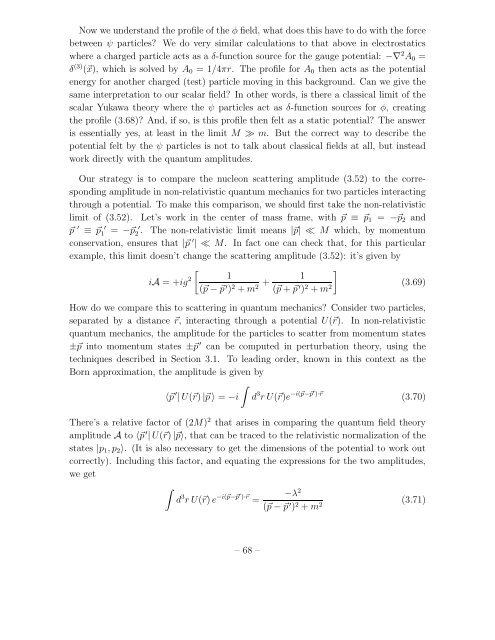Quantum Field Theory
Quantum Field Theory
Quantum Field Theory
Create successful ePaper yourself
Turn your PDF publications into a flip-book with our unique Google optimized e-Paper software.
Now we understand the profile of the φ field, what does this have to do with the forcebetween ψ particles? We do very similar calculations to that above in electrostaticswhere a charged particle acts as a δ-function source for the gauge potential: −∇ 2 A 0 =δ (3) (⃗x), which is solved by A 0 = 1/4πr. The profile for A 0 then acts as the potentialenergy for another charged (test) particle moving in this background. Can we give thesame interpretation to our scalar field? In other words, is there a classical limit of thescalar Yukawa theory where the ψ particles act as δ-function sources for φ, creatingthe profile (3.68)? And, if so, is this profile then felt as a static potential? The answeris essentially yes, at least in the limit M ≫ m. But the correct way to describe thepotential felt by the ψ particles is not to talk about classical fields at all, but insteadwork directly with the quantum amplitudes.Our strategy is to compare the nucleon scattering amplitude (3.52) to the correspondingamplitude in non-relativistic quantum mechanics for two particles interactingthrough a potential. To make this comparison, we should first take the non-relativisticlimit of (3.52). Let’s work in the center of mass frame, with ⃗p ≡ ⃗p 1 = −⃗p 2 and⃗p ′ ≡ ⃗p 1 ′ = −⃗p 2 ′ . The non-relativistic limit means |⃗p| ≪ M which, by momentumconservation, ensures that |⃗p ′ | ≪ M. In fact one can check that, for this particularexample, this limit doesn’t change the scattering amplitude (3.52): it’s given by[]iA = +ig 2 1(⃗p − ⃗p ′ ) 2 + m + 1(3.69)2 (⃗p + ⃗p ′ ) 2 + m 2How do we compare this to scattering in quantum mechanics? Consider two particles,separated by a distance ⃗r, interacting through a potential U(⃗r). In non-relativisticquantum mechanics, the amplitude for the particles to scatter from momentum states±⃗p into momentum states ±⃗p ′ can be computed in perturbation theory, using thetechniques described in Section 3.1. To leading order, known in this context as theBorn approximation, the amplitude is given by∫〈⃗p ′ |U(⃗r) |⃗p 〉 = −i d 3 r U(⃗r)e −i(⃗p−⃗p′ )·⃗r(3.70)There’s a relative factor of (2M) 2 that arises in comparing the quantum field theoryamplitude A to 〈⃗p ′ |U(⃗r) |⃗p〉, that can be traced to the relativistic normalization of thestates |p 1 , p 2 〉. (It is also necessary to get the dimensions of the potential to work outcorrectly). Including this factor, and equating the expressions for the two amplitudes,we get∫d 3 r U(⃗r) e −i(⃗p−⃗p′ )·⃗r −λ 2=(3.71)(⃗p − ⃗p ′ ) 2 + m 2– 68 –
















